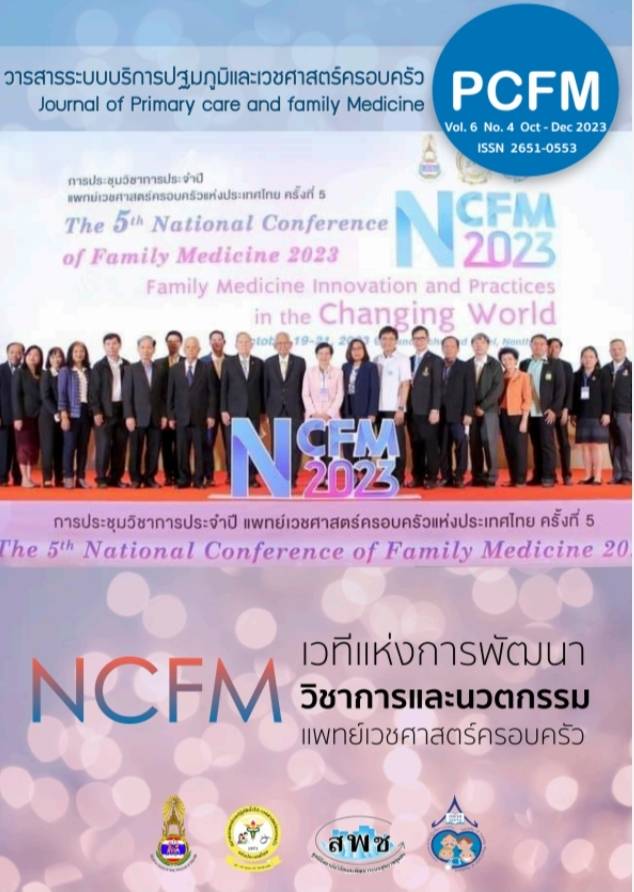ปัจจัยที่ส่งผลต่อความไม่ร่วมมือของผู้ดูแลในการให้ยาน้ำเสริมธาตุเหล็กแก่เด็กอายุ 6 เดือนถึง 5 ปี
Main Article Content
บทคัดย่อ
บทคัดย่อ
ที่มา: สาเหตุส่วนใหญ่ของภาวะโลหิตจางในเด็กเกิดจากการขาดธาตุเหล็ก แม้ว่ากระทรวงสาธารณสุขมีมาตรการเสริมธาตุเหล็กให้เด็กไทยอายุ 6 เดือนถึง 5 ปี แต่ความชุกของภาวะโลหิตจางในจังหวัดชลบุรียังคงสูง
วัตถุประสงค์: ศึกษาปัจจัยที่ส่งผลต่อความไม่ร่วมมือของผู้ดูแลในการให้ยาน้ำเสริมธาตุเหล็ก
วิธีการศึกษา: การศึกษาวิจัยเชิงพรรณนาแบบภาคตัดขวางในกลุ่มผู้ดูแลเด็กจำนวน 154 คนที่มารับบริการคลินิกเด็กดีในพื้นที่อำเภอเมือง จังหวัดชลบุรี ตั้งแต่เดือนกรกฎาคม ถึงเดือนกันยายน 2564 เก็บข้อมูลด้วยแบบสอบถาม วิเคราะห์หาความสัมพันธ์เชิงสถิติด้วยสมการถดถอยโลจิสติกแบบไบนารี (Binary logistic regression)
ผลการศึกษา: กลุ่มตัวอย่างร้อยละ 55.2 ไม่ร่วมมือในการให้ยาน้ำเสริมธาตุเหล็ก จากการวิเคราะห์ พบว่าปัจจัยที่ส่งผลต่อความไม่ร่วมมือในการให้ยาอย่างมีนัยสำคัญทางสถิติ (p<0.05) ได้แก่ ผู้ดูแลลืมให้เด็กรับประทานยา (p<0.01) เด็กปฏิเสธไม่ยอมรับประทานยา (p<0.01) และเด็กเกิดอาการข้างเคียงทางเดินอาหาร (p=0.04)
สรุป: ความไม่ร่วมมือในการให้ยาน้ำเสริมธาตุเหล็กขึ้นกับปัจจัยหลายประการ คลินิกเด็กดีของสถานบริการปฐมภูมิควรวางแนวทางในการประเมินความร่วมมือของผู้ดูแลเรื่องการให้ยา รวมถึงให้ความรู้แก่ผู้รับบริการต่อไป
Article Details

อนุญาตภายใต้เงื่อนไข Creative Commons Attribution-NonCommercial-NoDerivatives 4.0 International License.
เนื้อหาและข้อมูลในบทความที่ลงตีพิมพ์ในวารสาร PCFM ถือเป็นข้อคิดเห็นและความรับผิดชอบของผู้เขียนบทความโดยตรง ซึ่งกองบรรณาธิการวารสารไม่จำเป็นต้องเห็นด้วยหรือร่วมรับผิดชอบใด ๆ
บทความ ข้อมูล เนื้อหา รูปภาพ ฯลฯ ที่ได้รับการตีพิมพ์ลงในวารสาร PCFM ถือเป็นลิขสิทธิ์ของวารสาร PCFM หากบุคคลหรือหน่วยงานใดต้องการนำทั้งหมดหรือส่วนหนึ่งส่วนใดไปเผยแพร่ต่อหรือเพื่อกระทำการใด ๆ จะต้องได้รับอนุญาตเป็นลายลักษณ์อักษรจากวารสาร PCFM ก่อนเท่านั้น
เอกสารอ้างอิง
Powers J. Iron deficiency in infants and children <12 years: Screening, prevention, clinical manifestations, and diagnosis [Internet]. Uptodate.com. 2020 [cited 17 March 2021]. Available from: https://www.uptodate.com/contents/iron-deficiency-in-infants-and-children-less-than12-years-screening-prevention-clinical-manifestations-and-diagnosis/print#!
South East Asian Nutrition Surveys team. South East Asian Nutrition Surveys: Regional overview on nutrition and health trends, 2012.
คู่มือแนวทางการควบคุมและป้องกันโลหิตจางจากการขาดธาตุเหล็ก. สำนักโภชนาการ กรมอนามัย กระทรวงสาธารณสุข, 2556.
Bangsombun S. Prevalence and Related Factors of Iron Deficiency Anemia among Infants Age 6 Months at Health Promoting Hospital, Regional Health Promotion Center 3. Nursing Public Health and Education Journal. 2018;19(1).
Li Q, Liang F, Liang W, Shi W and Han Y. Prevalence of Anemia and Its Associated Risk Factors Among 6-Months-Old Infants in Beijing. Front. Pediatr. 2019; 7:286.
Zuffo CR, Osório MM, Taconeli CA, Schmidt ST, da Silva BH, Almeida CC. Prevalence and risk factors of anemia in children. J Pediatr (Rio J). 2016;92:353---60.
Baker R, Greer F. Diagnosis and Prevention of Iron Deficiency and Iron-Deficiency Anemia in Infants and Young Children (0-3 Years of Age). PEDIATRICS. 2010;126(5):1040-1050. [Available at https://pediatrics.aappublications.org/content/126/5/1040]
Aphikulchatkit Y. Prevalence of anemia and effectiveness of weekly iron supplementation in the prevention of anemia among infants aged 9-12 months in well baby clinic, Police General Hospital. Journal of The Police Nurses. 2020; 12(1).
Brunken G, Muniz P, Silva S. Weekly iron supplementation reduces anemia prevalence by 1/3 in preschool children. Revista Brasileira de Epidemiologia. 2004;7(2):210-219.
Autthawee B, Phongphetdit B. Control and prevention of iron deficiency anemia in children aged 6-12 months. Nursing Journal of The Ministry of Public Health, 2020; 30(1), 82-93.
Duangpetsang J. Anemia in children aged 6-12 month in Well Child Clinic at Kaengkhro hospital. Chaiyaphum medical journal. 2017; 37(2).
สรุปผลการดำเนินงานการจ่ายยาน้ำเสริมธาตุเหล็กในเด็ก 6 เดือนถึง 2 ปี. กรมอนามัย ศูนย์อนามัยที่ 6 จังหวัดชลบุรี; 2020.
Iron deficiency anemia Assessment, Prevention, and Control, WHO, 2001.
World Health Organization (WHO). Prevalence of anaemia in children under 5 years. Retrieved from https://www.who.int/data/gho/data/ indicator - details/GHO/prevalence-of-anaemia-in-childrenunder-5-years-(-),2020.
Leelapiromchai P. Effectiveness of daily and weekly iron supplementation in the prevention of anemia in toddler (Thesis, the Diploma of Thai Board of Pediatrics of The Medical Council). Department of pediatrics, Faculty of medicine, Chulalongkorn University, Bangkok, Pathum Wan, 2013.
Christensen L. Anemia and adherence to oral iron supplementation in a sample of children assisted by the public health network of Rosario, Santa Fe. Archivos Argentinos de Pediatria. 2013;111(4):288-294.
Bilenko N, Yehiel M, Inbar Y, Gazala E. The association between anemia in infants, and maternal knowledge and adherence to iron supplementation in southern Israel. Isr Med Assoc J. 2007 Jul;9(7):521-4.
Souganidis E, Sun K, de Pee S, Kraemer K, Rah J, Moench-Pfanner R et al. Relationship of Maternal Knowledge of Anemia with Maternal and Child Anemia and Health-Related Behaviors Targeted at Anemia Among Families in Indonesia. Maternal and Child Health Journal. 2012;16(9):1913-1925.
Krause B. THORNDIKE, R. M.: Correlation Procedures for Research. Gardner Press, Inc., New York 1978. 351 S., £ 15.15. Biom J. 1978;21(4):183–4.
Maneesriwongul WL, Tulathong S, Fennie KP, Williams AB. Adherence to Antiretroviral Medication Among HIV Positive Patients in Thailand. J Acquir Immune Defic Syndr. 2006;43:S119-S22.
Kangwal C, Kongsaktrakol C, Maneesriwongul W, Visudtibhan A. Factors Related to Medication Adherence among Children with Epilepsy. Rama Nurs J. 2017;23(1).


